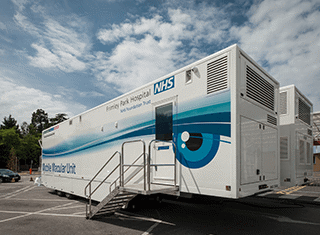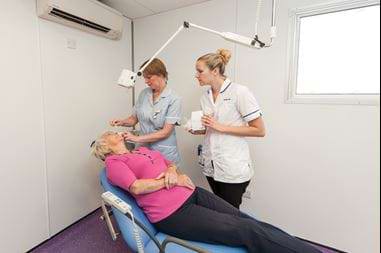Mobile Ophthalmology Units | A look beyond the hospital walls
 Keith Austin
Keith Austin
Published 10 June 2018
 Clinical capacity
Clinical capacity
Why it’s vital for ophthalmologists to look outside the hospital environment to tackle today’s capacity challenges.
The rising prevalence of eye disease is no secret. In the UK, it’s predicted that we’ll see an increase of 100,000 wet AMD cases in the 10 years to 2020, whereas the number of glaucoma cases will rise by almost 300,000 (1). Patients are already losing sight unnecessarily because of capacity problems in eye clinics (2), leading me to wonder what the situation will look like in another decade if nothing changes.
It begs the question; how are ophthalmologists expected to adhere to such an escalating demand – a demand that will not reduce so long as we have an aging population? With evening and weekend clinics already operating at full capacity, and hospital refurbishments often unaffordable, it’s vital that clinicians consider more innovative and sustainable methods of delivering care.

A facility that is becoming increasingly popular amongst trusts looking to run clinics more efficiently is mobile medical units that provide fully independent assessment and treatment services right in the heart of community locations, complete with all the amenities expected in a modern clinic. The support for flexible infrastructure such as this extends across the NHS, with the Five Year Forward View highlighting out of hospital care as one of the main priorities for coping with today’s healthcare landscape (6). For ophthalmology, delivering care in more convenient locations rather than an often-hectic hospital environment is the single most effective method of dealing with rising patient numbers. Mobile ophthalmology units installed in easily accessible sites can quickly create up to 250 more patient slots per week and can reduce the time spent waiting for and attending appointments by up to 50 minutes, which, ultimately, eliminates the need for evening and weekend clinics.

For patients, travelling to and from hospitals can be stressful and time-consuming when attending regular treatment, but the burden of travel is amplified for those with reduced vision. Mobile community-led care gives eye patients the option to receive assessment and treatment, including intravitreal injections and cataract surgery, within a nearby, easily-accessible location. With more patients treated within target waiting times, whether for AMD, glaucoma, cataracts, or other time-critical eye conditions, more of the population will preserve healthy eyesight and require lower levels of both state-funded support and unpaid care. These people can then remain economically productive and enjoy a higher quality of life, whilst consultants can provide uncompromised care under circumstances alleviated from pressure. This vision of convenient, efficient and flexible macular clinics will only materialize if decision makers collectively look beyond ageing hospital estates to manage the continuous surge in eye health conditions set for the next 20 years.
Read the full 'In My View' article by Keith Austin in The Ophthalmologist
References
1. RNIB, “Saving money, losing sight” (2013). Available at online at: bit.ly/2vr9yNJ. Last accessed April 2018
2. C MacEwen, “Increasing demand on hospital eye services risks patients losing vision” (2016). Available online at: bit.ly/2EQ8Sk4. Last accessed April 2018
6. NHS England, “Next Steps on the NHS Five Year Forward View” (2017). Available at: https:// bit.ly/2wPmJYG. Last accessed April 2018